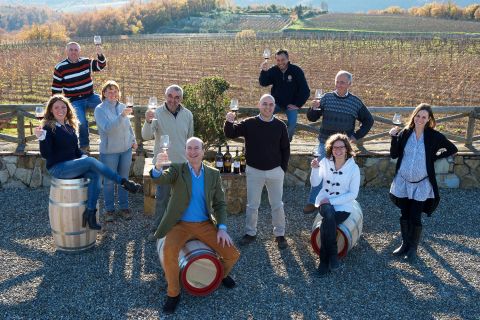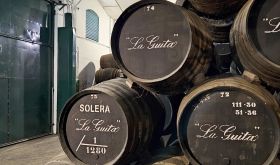From €15.50, $18.94, £21, CA$32.99, AU$42.99, 4,257 Japanese yen
In Portland, Oregon, it began to drizzle this week. Not enough to put remaining picks of Willamette Valley grapes at much of a risk, but enough to signal an entry into dreary cool weather and prompt quicker harvesting. Along the same lines, summer produce is thinning out, and I have enthusiastically snapped up the last of the season’s tomatoes and thrown them into sauces with smashed garlic, olive oil and herbs to ladle over spaghetti squash and top with parmesan. Mushroom soup, baked delicata squash salad with pomegranate, sage and burrata, and aubergine with crispy, cumin-scented beef and more pomegranate kernels are on the menu. Thick wool socks have been donned, Iron and Wine’s ‘Autumn Town Leaves’ played multiple times, and my 18-year-old dog has begun refusing to take walks and claiming ownership of any sweaters left on the couch. It is a red-wine week.
When I walked into my local wine shop and came away with a 2020 Rocca di Montegrossi Chianti Classico I was expecting a decent pairing for the tomatoes and garlic. But for $24 I did not expect the blossoming layers of savoury tomato leaf, dried tart cherry, leather and dusty earth. Stunned by the value packed into this bottle, I browsed our tasting-note database to find that Walter already knew about this gem, scoring it 17++ and describing it thus: ‘Lustrous ruby. A tiny bit reductive on the nose and a little leathery with brooding fruit underneath. Suave sour-cherry fruit with long grainy tannins. Very long, fragrant and succulent, but needs more time in the bottle.’ This does not seem to be an isolated incident: vintages 2016–2021 all received 17-point scores. And the wine is well distributed!
The estate from which the Rocca di Montegrossi wines are made lies in the commune of Gaiole. This is considered one of the most historic communes within Chianti Classico; it is where Barone Bettino Ricasoli – the great-great-great grandfather of current proprietor Marco Ricasoli-Firidolfi (below) – first recorded the ‘recipe’ for Chianti. While one branch of the Barone’s descendants own and run the famous Barone Ricasoli, this estate was started in 1966, when Ricasoli-Firidolfi’s father, Alberto, began planting vines on a stony, calcareous plateau at 340–510 m (1,115–1,673 ft) above sea level in the subzone of Monti. The soils here are particularly high in limestone, and therefore calcium, which inhibits potassium uptake in vines, giving the local Sangiovese its bright natural acidity and deep colour.
When Ricasoli-Firidolfi took over the family estate in 1994 he set about improving the property, building a new cellar in 1999 and converting the estate’s 20 ha (49 acres) of vineyards to organic farming in 2006 (certified in 2010). The Chianti Classico DOCG is what he calls the estate’s ‘flagship’ wine, preferring this to the terms ‘entry-level’ or ‘normale’. He makes it with fruit off his younger vines, 10–15 years in age, mostly Sangiovese (91% in 2020) with small amounts of Canaiolo and Colorino.
Winemaking is relatively simple, with spontaneous fermentation taking place in lined concrete over the course of two to three weeks (only 12 days in 2020). The wine is then aged in large cask, barrel and concrete for around one year (11 months in 2020). It is then bottled unfined and aged for a further six months prior to release. The result has enough bright acidity, fine sandy tannins and concentration of fruit to improve through at least the end of the decade. I will be returning to my local shop to pick up a few more bottles to stash away for next fall … and perhaps even the one after if I don’t drink them all!
In the US, Rocca di Montegrossi is imported by North Berkeley Imports, and in the UK by Flint Wines.
Members can access another 3,000-plus tasting notes on Chianti Classico in our tasting note database, plus Walter's in-depth vintage reports.
















